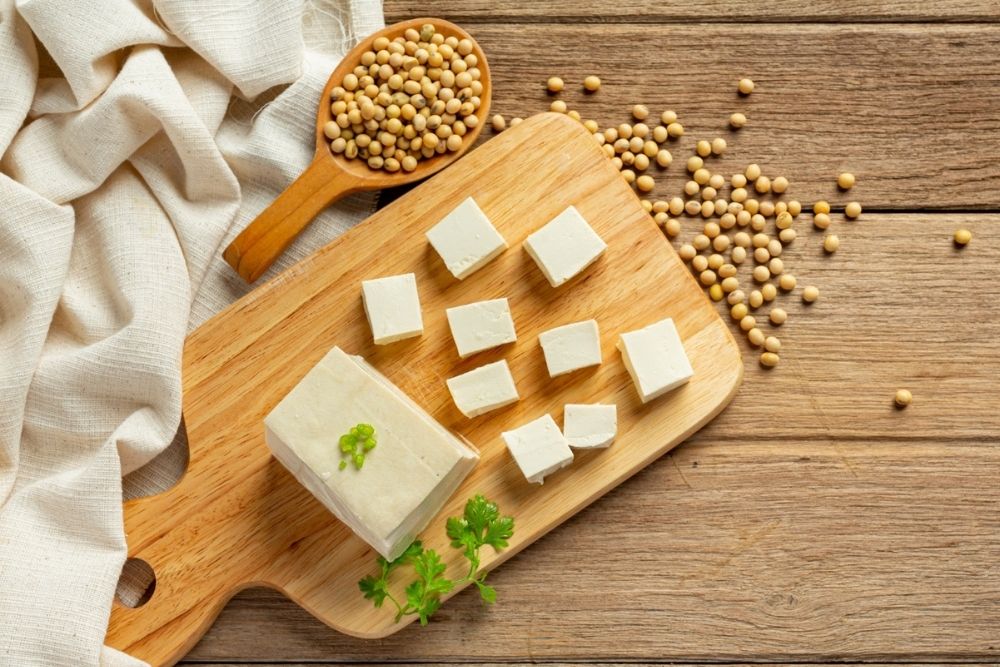If you’re new to tofu, it is a dairy-free soybean curd with a similar texture and appearance of cheese. The bland flavor provides a wonderful blank palette upon which you can layer a variety of seasonings to achieve different flavor profiles. Let’s learn about the many ways to enjoy tofu and the health benefits it provides.
How is Tofu Made?
Raw, dried soybeans are soaked overnight then blended to make soymilk. A coagulant is added, which allows the liquid to curdle and become a solid. It is then drained and pressed into blocks. Tofu texture varies depending on moisture which is how we get varieties such as silken, medium, firm, or extra firm.
3 Health Benefits
You may have heard about a link between soy and risk for cancers. Recent research has refuted that concern. The phytoestrogens in tofu are considered “weak estrogens” that have a negligible effect on your body’s hormone levels. (Phytoestrogens found in soy supplements (e.g., capsule form) are more concentrated; these are the products that people have been cautioned not to take unless under medical supervision).
- Soy foods contain isoflavones. Isoflavones are a group of phytoestrogens, studied for their cancer prevention properties when you consume 2 servings per day.
- Tofu contains antioxidants which protect our cells against damage and inflammation that can increase risk for chronic disease.
- Tofu is also rich in calcium which is good for our bones and muscles.
Cooking with Tofu
When cooking, you might like to use ghee, butter, grapeseed oil, sesame oil, plain or seasoned extra virgin olive oil to name a few options. A general cooking guide for tofu varieties:
- Firm and extra-firm tofu is denser than soft or silken tofu and retains more of its shape when cooked. This makes it suitable for grilling and stir-frying.
- Soft tofu works well in casseroles and soups.
- Crumbled tofu is great for a skillet scramble and can replace cottage cheese in vegan lasagna.
- Silken tofu is best for puddings and dips; it can be blended into smoothies for added protein.
Buying “naked tofu” to season with herbs of your choosing is the best bet for high quality nutrients and flavor. Tofu can be baked, broiled, or simmered and stir-fried on the stove. You can season tofu by using:
fresh or dried herbs such as garlic, onion, parsley, basil, thyme, rosemary, tarragon, cumin, and saffron
marinades such as honey-mustard, tamari, tomato sauce, salsa, lemon/lime
Whenever possible, buy organic tofu (or organic sprouted tofu) so you can avoid environmental toxins and GMOs. It’s also a good idea to avoid buying pre-seasoned tofu which can be loaded with sodium. Be sure to read the ingredient label to see what is being used to season pre-packaged tofu.
Resources
Barrett, J. R. “The science of soy: What do we really know? Environmental Health Perspectives” 114(6), A352–A358. June 2006. https://www.ncbi.nlm.nih.gov/pmc/articles/PMC1480510/
“Hexane in soy food.” May 1, 2012. http://www.berkeleywellness.com/healthy-eating/food-safety/article/hexane-soy-food
Isoflavones. http://www.isoflavones.info/
Jargin, S. V. “Soy and phytoestrogens: Possible side effects.” German Medical Science. 12(18). 2014. https://www.ncbi.nlm.nih.gov/pmc/articles/PMC4270274/
Lanou, A. J. “Soy foods: are they useful for optimal bone health? Therapeutic Advances in Musculoskeletal Disease.” 3(6), 293–300. 2011. https://www.ncbi.nlm.nih.gov/pmc/articles/PMC3383497/
Foodyourself.com “Tofu 101: The Health Benefits of Tofu – and How to Cook It”. January 2019. https://www.foodyourself.com/blog/2019/1/15/tofu-101-the-health-benefits-of-tofu-and-how-to-cook-it

